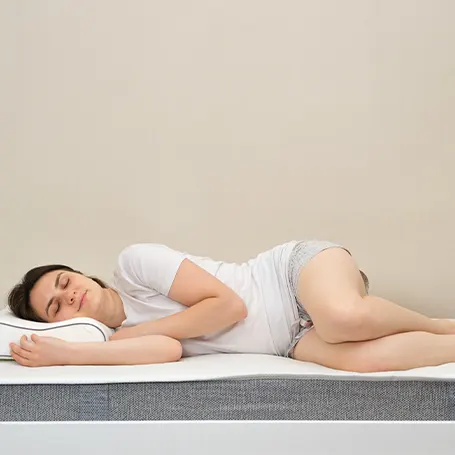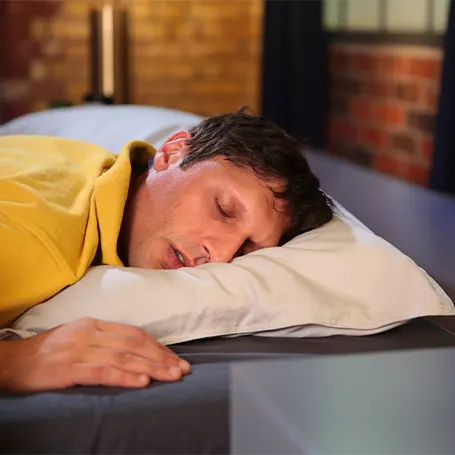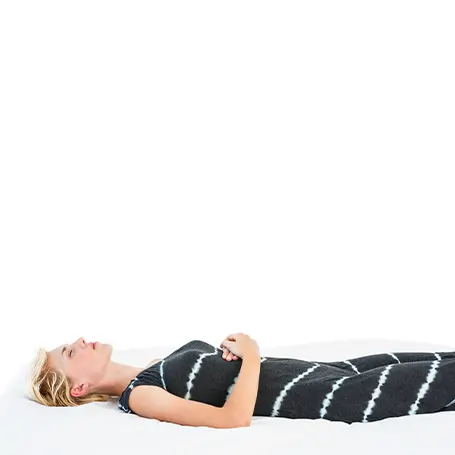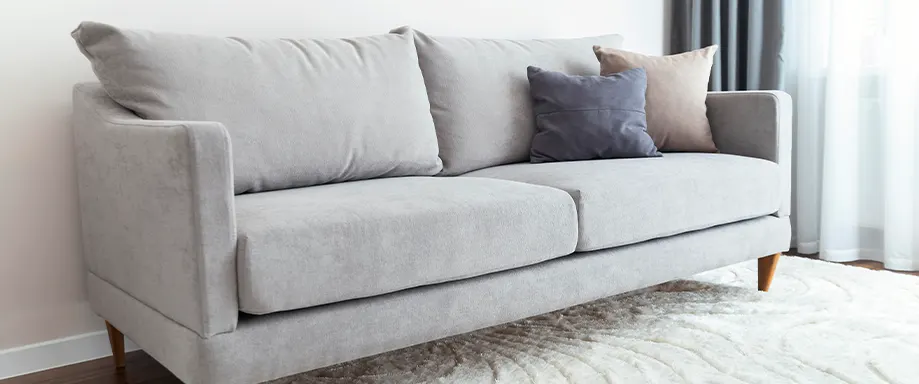Can you permanently change your sleeping position?
To start things off, let's get this out of the way – yes, you can change your sleeping position. It's just a habit and your body will adapt.
Now let's go over all how you can train yourself to switch between sleeping positions. There are quite a few ways to go about doing this but keep one important thing in mind – it takes time to break a habit.
So, if your new sleeping position doesn't take during the first few nights or you find it difficult to get a good night's sleep in your new sleeping position, don't worry. While it's not ideal, it's not unusual either. And as long as you stick with it, your body will adjust.
Also, if you want to know more about sleeping positions and how they affect your health, stick around until the end. After all, you might just find that a health problem you're currently having is caused by your sleeping position!
How to always sleep on your side

Side sleeping is very common and very practical. So, it shouldn't be a surprise that almost 3/4 of people prefer side sleeping over other sleeping positions. With that being said, side sleeping isn't always the best sleep position but we'll talk more about that later.
For now, let's stick to how you can sleep on your side! The simplest way to go about this is to create some sort of barrier that will prevent you from rolling onto your back or your stomach.
Use pillows
If you're afraid that you'll roll onto your back, get a supportive pillow and place it behind you. Bonus points if your bed is also near a wall. In that case, you can turn your back to the wall and put the pillow between yourself and the wall.
Since the pillow has nowhere to go, you'll likely stay on your side. However, you can still roll over onto your stomach. And as we'll see later on, stomach sleeping is less than ideal in some situations. But we'll talk more about that later on.
Use a U-shaped or pregnancy pillow
Pregnant women aren't the only ones who can benefit from a good pregnancy pillow! In fact, a pregnancy or U-shaped pillow might be exactly what you're looking for. After all, it basically wraps around you and provides support from the front and back.
Not only does this make sleeping in the fetal position a lot more comfortable but it also makes flipping over more difficult. After all, when you look at something like the Kally U-shaped pillow, you'll see that it doesn't leave a lot of room for you to flop around.
Use tennis balls
Another common way to change your sleep style is by simply making the other two a lot less comfortable. In this example, you'd simply tape tennis balls to your stomach and your back. So, whenever you try to roll over, the tennis balls would make you uncomfortable and you'd likely just roll back onto your side.
With that being said, this isn't our favourite tip. After all, you might end up with a bruise if you do manage to fall asleep on your stomach or back. Plus, the tennis balls can “escape” if you toss and turn a lot. Not to mention that if you already have some sort of health issues, this could make the associated pain worse if you end up in a weird position.
So, while it can definitely work for some people, we'd recommend trying out different methods first.
Sleep on a smaller bed
On a similar note to the previous tip, you can just “eliminate” the option to change sleeping positions! For example, if you sleep on a sofa bed, don't pull out your bed at all and instead sleep on the cushions.
Then you can scoot your back to the backrest, removing the ability to flip onto your back. And since the seat cushions are likely very small, you won't be able to flip onto your stomach either.
However, this isn't a long-term solution. The seat cushions likely can't account for your natural curve and you might end up with hip pain (as well as a lack of restful sleep). Getting a good mattress topper can minimise this issue but generally, you want to sleep in a proper bed.
Should you sleep on your stomach?

You might have noticed that we've mostly just focused on how to switch from sleeping on your back to sleeping on your side. Stomach sleeping on the other hand has mostly been absent. And that's for good reason!
Generally, sleeping on your stomach can be safe and comfortable. However, there's a lot more you need to consider as a stomach sleeper. After all, you're putting a lot of unnecessary pressure on your stomach and the vast majority of pillows aren't suited for this sleep position. So, let's quickly go over a few things you should be aware of.
Having a proper pillow
From the start, sleeping on your stomach isn't ideal as your head is turned at a 90-degree angle all night long. So, you're already begging for neck pain in the morning. However, this isn't where your potential neck pain issues stop!
Aside from being tilted to the side, your head can also end up tilted upwards if you don't have the appropriate pillow underneath. Generally, the best pillow for stomach sleepers is going to be lying flat and very thin. This is because if you don't have a thin pillow, your head will have to be tilted during the night.
Having a proper mattress
The second big factor you should keep in mind is your mattress. And that's because, unlike a side sleeper who wants their hip and shoulder to sink into the mattress, you want your body to stay completely flat.
This is why mattresses for front sleepers will typically be very firm. You can also put a pillow under your hips so that you can keep your spine aligned and avoid the back pain caused by sleeping in a “slouched” position.
Why shouldn't you sleep on your back?

Lastly, let's talk about why you should avoid sleeping on your back in the first place.
And the fact of the matter is, unlike sleeping on your stomach, we generally don't discourage people from sleeping on their backs.
In fact, when it comes to things such as acid reflux, sleeping on your back can make your life a lot easier.
However, there are also situations where sleeping on your side is a better option.
So, in case you didn't come here with any specific health issues but rather just want to know how different sleep positions potentially affect your health, here are a few general guidelines.
Obstructive sleep apnea and/or snoring
The most common reason people want to avoid sleeping on their backs is due to obstructive sleep apnea and/or snoring. After all, when you sleep on your back, gravity will make it a lot easier for your tongue to slide back and block your airway.
So, if you or your partner are experiencing this condition or tend to snore every night, switching to your side is bound to help you out in the long run.
Neck and/or back pain
Just like with stomach sleepers, not every pillow or mattress is going to be a perfect fit for you. And since side sleepers reign supreme, it's best to know what you're looking for as the odds are stacked against you.
When it comes to neck pain, your pillow is probably just too thick. After all, you want your neck to be straight and in line with your spine and a thicker pillow will force your head to tilt downwards.
As far as mattresses are concerned, it's a similar situation to stomach sleepers (although usually not as severe). Generally, you just want to make sure that your hips aren't sinking too far into your mattress. After all, this will lead to your butt “sticking out” and putting pressure on your lower back.
Conclusion
For a lot of people and in a lot of cases, sleeping on your back is completely fine and safe. However, if you do have to switch to your side, you now know how to do it! Just stay persistent and your body will adapt over time. And if you want to switch over to sleeping on your stomach, we hope you take our advice into consideration and get the proper gear.
So, trusty Advisee, you now know how to avoid sleeping on your back! If there are any other questions you have about sleep health or bedding, make sure to leave them in the comments or contact us directly.















There are no comments yet
"*" indicates required fields